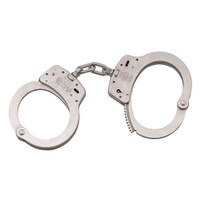Pros and Cons of Civilian Use of Professional Law Enforcement Police Handcuffs
Before we dive into the details of civilian use of professional law enforcement handcuffs, it's important to note that this information is not legal advice and is provided solely for informational purposes. Laws surrounding the use of handcuffs by civilians vary greatly by jurisdiction, and nothing in this article should be taken as guidance or legal advice. If you are a civilian considering purchasing or using handcuffs, you should consult a legal expert to ensure compliance with local laws and regulations.
Civilians may legally purchase handcuffs in many regions, raising important questions about when and how they should be used. In this article, we'll explore the different types of handcuffs and the pros, cons and common civilian uses of these high-quality restraint tools.
Types of Professional Handcuffs
Professional-grade handcuffs from brands like Smith & Wesson, Peerless, and ASP are built for law enforcement use, constructed from high-strength materials such as carbon or stainless steel, ensuring durability and reliability under stressful conditions. These handcuffs feature advanced locking mechanisms like the double-lock, which prevents the cuffs from over-tightening and reduces the risk of injury to the restrained individual.
Most professional handcuffs use a universal handcuff key compatible across various brands, making them efficient for law enforcement agencies. However, some advanced restraint systems may require specialty keys for added security and specific applications.
When it comes to law enforcement handcuffs, four primary types are widely used: chain-linked, hinged, rigid handcuffs, and zip tie (flex) cuffs. Each offers a different balance of flexibility, control, and restraint strength.
Chain-Linked Handcuffs
- Description: Chain-linked handcuffs have a short chain (usually two or three links) connecting the two cuffs, allowing a degree of wrist movement.
- Usage in Law Enforcement: These cuffs are commonly used by law enforcement for routine arrests. The chain offers some flexibility, making them more comfortable for the detainee during transport or extended wear.
- Scenarios: Typically used in low-risk situations where the suspect is expected to be compliant.
Hinged Handcuffs
- Description: Hinged handcuffs replace the chain with a hinge, reducing the mobility of the wearer’s wrists. This allows officers to exert more control over the restrained individual.
- Usage in Law Enforcement: Hinged cuffs are often used in situations where officers need to restrict a suspect’s ability to maneuver their hands and arms, such as when dealing with a potentially uncooperative individual.
- Scenarios: Preferred in medium-risk scenarios where the suspect may be more likely to resist or flee.
Rigid Handcuffs
- Description: Rigid handcuffs offer no flexibility between the cuffs. The lack of a connecting chain or hinge gives the officer maximum control over the detainee's movements.
- Usage in Law Enforcement: These are typically used in high-risk situations, such as when an individual poses a significant threat or is expected to resist arrest violently.
- Scenarios: Most often seen in tactical operations or when dealing with dangerous suspects who may attempt to harm others or escape.
Zip Tie (Flex) Cuffs
- Description: Zip tie handcuffs, also known as flex cuffs, are disposable plastic restraints made from high-tensile strength nylon. They are often used as a quick and lightweight alternative to traditional metal handcuffs, especially when detaining large numbers of people.
- Usage in Law Enforcement: Flex cuffs are frequently used in crowd control situations, such as protests or large public disturbances, where officers may need to restrain multiple individuals quickly. Their lightweight, inexpensive design allows law enforcement officers to carry multiple sets and apply them efficiently.
- Scenarios: Ideal for mass arrests or temporary detainment during large-scale operations. Zip tie cuffs are also commonly used by military personnel, correctional officers, and sometimes private security forces.
- Pros:
- Lightweight and easy to carry.
- Cost-effective and disposable after use.
- Can be applied quickly in large numbers.
- Cons:
- Not as secure as metal handcuffs, as they can be cut or broken more easily.
- Less comfortable for the detainee, especially during extended use.
- Difficult to adjust once applied, which increases the risk of injury due to over-tightening.
Training for Civilian Use of Professional Handcuffs
For civilians interested in using professional-grade handcuffs, proper training is essential to ensure both safe and legal use. Unlike law enforcement officers who receive formal training, civilians may lack the knowledge needed to apply handcuffs correctly, which can lead to misuse, injury, or legal consequences.
Training programs teach key skills such as how to securely apply handcuffs without causing harm, how to recognize situations where their use is legally justified, and how to handle non-compliant individuals safely. Without this knowledge, even well-meaning attempts to restrain someone can result in charges like false imprisonment or assault.
You can easily find relevant training programs near you or online by conducting a quick Internet search. Some law enforcement or private security organizations may offer both in-person and online certification courses that cover handcuff use, legal boundaries, and safe application techniques. For any civilian considering the use of professional handcuffs, seeking this training is a critical step to ensure responsible, effective use.
Common Usages for Handcuffs by Civilians
While handcuffs are primarily associated with law enforcement, civilians in certain roles may also have legitimate reasons to use them. Here are some common civilian usages of professional-grade handcuffs:
1. Bail Bondsmen
Bail bondsmen, or bounty hunters, often use handcuffs to detain individuals who have skipped bail or failed to appear in court. These professionals are licensed to make arrests and use restraints, like handcuffs, to safely apprehend and transport fugitives back into custody.
2. Private Security Personnel
Private security professionals, especially those working in high-risk environments such as malls, events, or corporate settings, may use handcuffs to detain individuals involved in criminal activity until law enforcement arrives. In this role, handcuffs help maintain order and prevent suspects from escaping or causing further harm.
3. Loss Prevention Officers
Loss prevention officers, who work in retail settings to prevent theft, may use handcuffs to restrain shoplifters or individuals caught committing crimes on store property. Proper training is essential, as misuse of handcuffs in this context could lead to legal issues such as false imprisonment.
4. Self-Defense Situations
In rare cases, civilians may use handcuffs in self-defense situations to restrain a threatening individual until law enforcement arrives. However, it’s critical that civilians understand the legal boundaries of self-defense to avoid legal consequences, such as charges of assault or unlawful restraint.
5. Event Security
At large events or private gatherings, security personnel may be responsible for managing rowdy or dangerous individuals. Handcuffs provide a means to control such individuals safely, allowing the event to continue without disruption while awaiting police assistance.
Pros and Cons of Civilian Use of Professional Police Handcuffs
With professional handcuffs available for civilian purchase, it’s important to weigh the pros and cons of using these tools in non-law enforcement settings. Below, we briefly explore the potential benefits and risks of civilian use of professional-grade handcuffs from brands like Smith & Wesson, Peerless, and ASP.
Pros of Civilian Use of Professional Police Handcuffs
- Pro: Handcuffs provide a secure way to restrain individuals in self-defense or security roles, allowing civilians to control a threat until law enforcement arrives, especially when paired with proper training to ensure legal and safe use.
Cons of Civilian Use of Professional Police Handcuffs
- Con: Misusing handcuffs without proper training or legal justification can lead to serious legal consequences, including charges of false imprisonment or assault, as well as physical harm to the restrained individual.
Conclusion: Balancing the Benefits and Risks
While professional-grade handcuffs can be useful in self-defense and security roles, civilians must understand the legal and safety risks involved. Proper training is essential to ensure safe, lawful use. Before purchasing or using handcuffs, always consult local laws or seek legal advice to avoid serious consequences.

